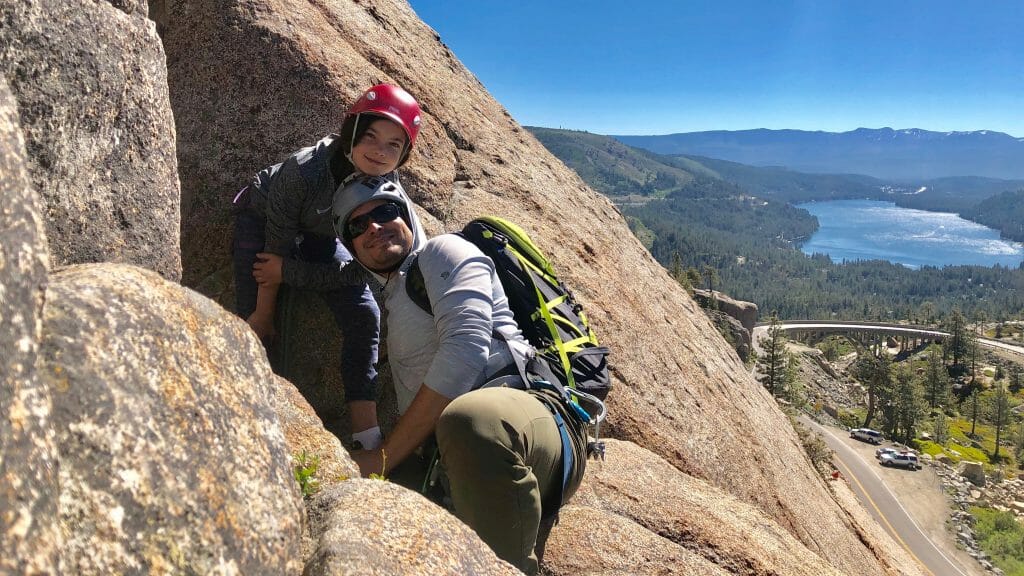Every time I see El Cap my stomach sinks, my hands start sweating, my heart pumps faster. Even today, even after climbing the Nose, El Cap still strikes me as being impossibly big. When you’re up there the granite sweeps above and below you like a strange vertical sea. It looks and feels like it will never end. I have to convince myself I was really there. That I did in fact climb a route I had always dreamed of doing but had assumed I would never do.
I’m a father of three with a full-time job, a decent climber but not an exceptional one. That I topped out on El Cap is surreal to me.
* * *
I first saw the Nose on a VHS tape I watched when I was 14 about Lynn Hill’s first free ascent of the Yosemite big wall. By then I had been climbing for a year, introduced to the sport by my sister and her friends, who had started a climbing program at my school in Mexico City. My younger brother also joined the small team, and he became one of my main climbing partners. It was a large part of our identity growing up—being climbers. And climbing the Nose was the dream we grew up with. “One day we’ll be able to do that,” we would say, only half-believing ourselves.
Because saying we wanted to climb the Nose was like saying we wanted to be astronauts when we grew up: it was too far-fetched of a dream to be possible. El Cap was the realm of the elites, those born with skills and fitness, and I was not an elite climber.
I faded from the sport in college, eventually abandoning climbing and adventuring altogether to pursue a career and start a family. During that time I also lost touch with my brother. Then in 2015, we reconnected over the phone. One of the things we talked about was how much we missed adventure and being outdoors. We started brainstorming ideas that would reunite us—with one another and with adventure.
We settled on a guided climb of Shuksan in Washington’s North Cascades for the following summer. In our minds this would open the door to maybe one day climbing an 8,000er. As I began to plan my training in early 2016, I came across Training for the New Alpinism. “You have to read this!” I told my brother. “This is our bible. This is what we should follow.”
For six months I stuck to a training plan based on the templates in the book, and in August my brother and I summited Shuksan via the Fisher Chimneys route. It was the first time we’d seen each other in about a decade; it was as if we’d never been apart.
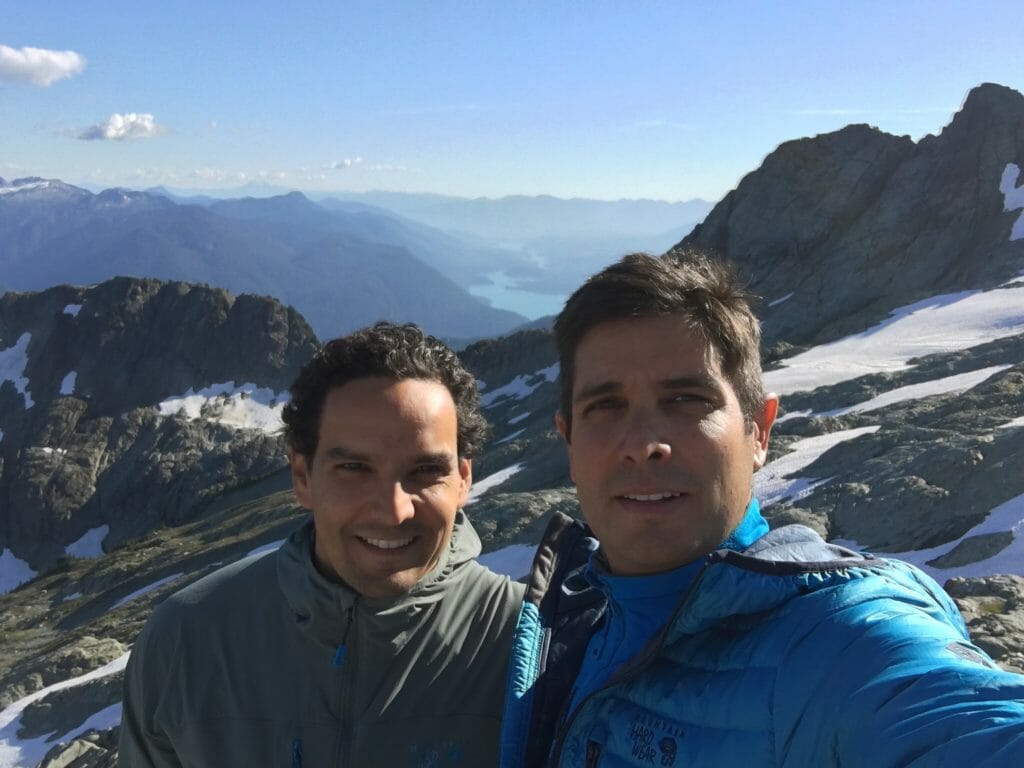
Shuksan lit a fire, and it wasn’t long before we zeroed in on two objectives for 2017: Snake Dike on Half Dome and the North Ridge of Mount Baker. El Cap still seemed like a fantasy, but Half Dome felt like a reasonable challenge. I bought a program from Uphill Athlete to guide my training.
My brother lives in Scotland, and at the time I was living in Florida. Although we were far apart in terms distance, we stayed connected through the training and keeping track of our progress. Later that summer, within one week, we were on top of Half Dome (with my climbing friend Jim) and then on top of Baker. Physically, I spent everything I had on those two climbs.
As amazing as Baker was, the objective hazard we encountered on the mountain—an open glacier, massive fallen seracs—had us questioning our pursuit of alpine climbing. We both have children and we’re the sole providers for our families. As we were weighing acceptable risk, working to align our values with our goals, a terrible tragedy gave shape to our fears: my 18-year-old nephew, an extremely talented climber and ski mountaineer, passed away in an accident in the Alps.
“We can’t do this alpine thing anymore,” I said to my brother in a call not long after.
My brother agreed, but he also made a valid point: “We don’t want to live out of fear. We don’t want to teach our children to limit themselves because of fear.”
“True,” I said. “We still need adventure in our lives. Climbing is something that makes us feel alive. So let’s find things that are more reasonable and that have a lot less objective hazard.” We set our sights on rock climbing, where you can find good bolts in good granite and the chance of being hit by an avalanche or bad weather is a lot smaller.
Still, some part of me must not have been fully convinced with the decision. It took an aborted attempt on Mount Rainier in 2018, after six of my best months of training to date, to hammer it home: I was done with alpine climbing. During that warmer-than-average summer, the mountain rumbled with falling ice. It was time to limit myself to solid rock.
* * *
A few weeks after Rainier, my brother and I met up in Yosemite for an aid climbing class with a local guide, Josh. In two days we learned the skills we would need for an El Cap big wall: how to aid climb, how to follow, how to clean, how to set up a portaledge. For the first time, the Nose no longer seemed like a hold just out of reach.
Josh became my technical mentor. That fall he put me through all sorts of challenges: roofs, lower-outs, complicated cleanouts—whatever he thought I needed to learn. By then my family and I had moved to the Los Angeles area, so it was easier for me to get to the valley.
I made it my mission for 2019 to climb the Nose, which would also line up nicely with doing it before turning 40 in 2020. But how would I train for three days of 10-to-12-hour pushes? That’s when I reached out to Uphill Athlete for a series of Custom 8-Week Plans.
Coach Seth Keena-Levin and I connected really well from the get-go. He understood where I was coming from—my fears and concerns. Plus, he had climbed the Nose; he knew what it would take. I started working on the program he gave me in January 2019. But after the first block I remained concerned about my physical capacity to do the climb.
“If you don’t top out it won’t be because of fitness,” Seth told me. “It may be because you drop your rack or the crowds slow you down, but you won’t fail due to fitness. You will be fit. You’ll be fit to the point where you can do it in style.”
His words helped me go for it. Once I knew I could have full faith in the process, I was able to throw myself into it.
That spring and summer I covered a lot of granite in the valley, working on bigger routes, bigger problems, bigger objectives. During those months, my brother, still based in Scotland, would join Josh and me whenever he could. But with the limitations of distance and time, it became clear to him by the end of the summer that he wasn’t going to be ready for the Nose by late fall. He stepped away from the project. I continued.
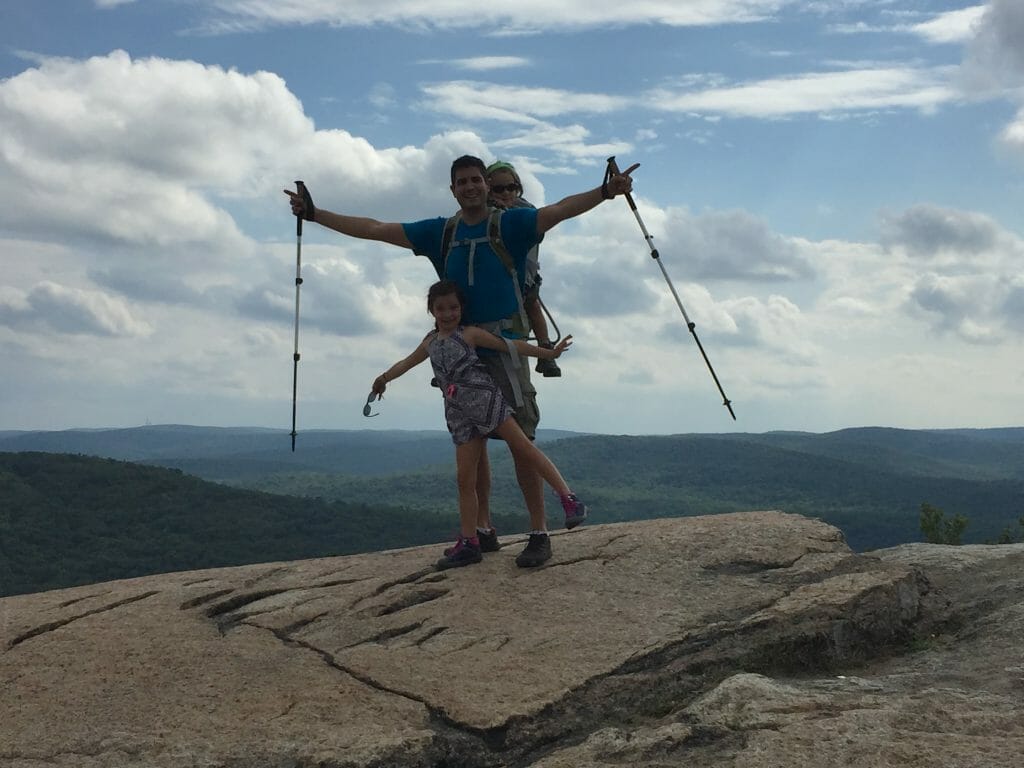
When I wasn’t in Yosemite or Joshua Tree, I was putting in hours at the climbing gym. One of the things Seth had me do was continuous climbing with weight, working up to 20 minutes up and down the wall nonstop with as much as 20 pounds. That’s where I saw the most improvement.
Throughout this long span of structured training, I would spend weeks in an uncomfortable stretch zone, often wondering if I’d finally gone as deep as I could go. Then the bottom of the well would yield a little more. Seeing those small, incremental gains took constant, consistent effort and sacrifice. Nothing came easy. But with commitment, those gains built over time into something big—an accomplishment that once seemed impossible.
Having the right mentors opened doors I never knew existed. Seth helped me get there physically, and Josh helped me get there technically. Surrounding myself with people who believed my goal to be possible made it believable for me.
That included my family, which grew by one as I was training for the Nose. They remained as engaged with my goal as I was. We got a big map of El Cap and I told them where I was going to be every day. They planned to draw a line along the route to track me.
* * *
Josh and I started up the wall on Wednesday, November 6, at 4 a.m. Going in, I was most nervous about the exposure—I’d never been 20-plus pitches off the ground—and the likelihood of having to deal with crowds on the popular route. What if we get stuck behind a slow party? What if we can’t find a place to sleep because the ledge we’re hoping to bivy on is already full?
Knowing that I had the fitness to push higher or go down to find another place to sleep helped ease those concerns. My physical confidence became mental confidence.
We planned to climb for about 12 hours each day, and each day, despite constantly being on the move—climbing, hauling, belaying, jumaring, managing the rope, eating, drinking, setting up and taking down the portaledge—I felt like I could have kept going for another 4 hours. Having that extra buffer helped me be fully present in this vast vertical world, a world as foreign as the moon.
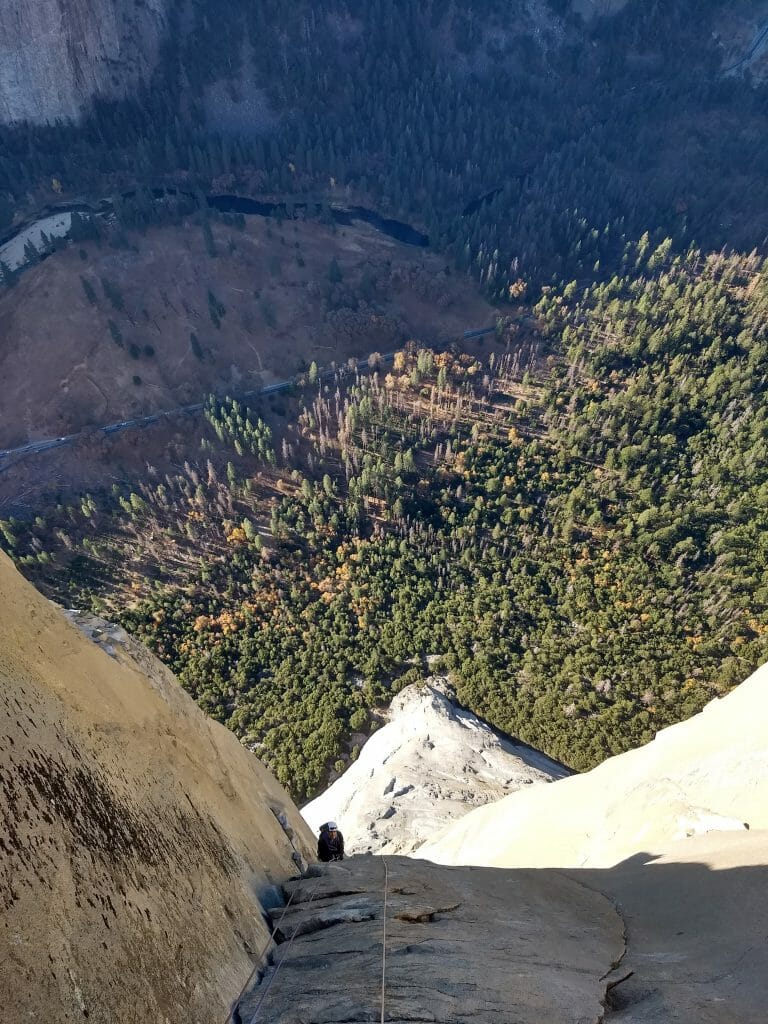
We learned that Lynn Hill had been working the Great Roof a few days before us, and while we were up there we met a young Belgian climber, Seb Berthe, who was in the process of freeing the route ground up. We watched him give his all on Changing Corners, the hardest pitch. There I was among the elites, feeling strong and enjoying the climb, not just suffering my way upward.
I still had reserves by the time we topped out, around noon on Friday after two bivies and 32 hours on the move. If we had needed to go on for another day, I could have done it.
Getting to the summit was beautiful and exhilarating. Getting back down was a relief. But getting home, that was my summit—when I was back in the arms of my wife and my children. That’s when I truly felt the accomplishment, which came with overwhelming gratefulness for their support and sacrifices.
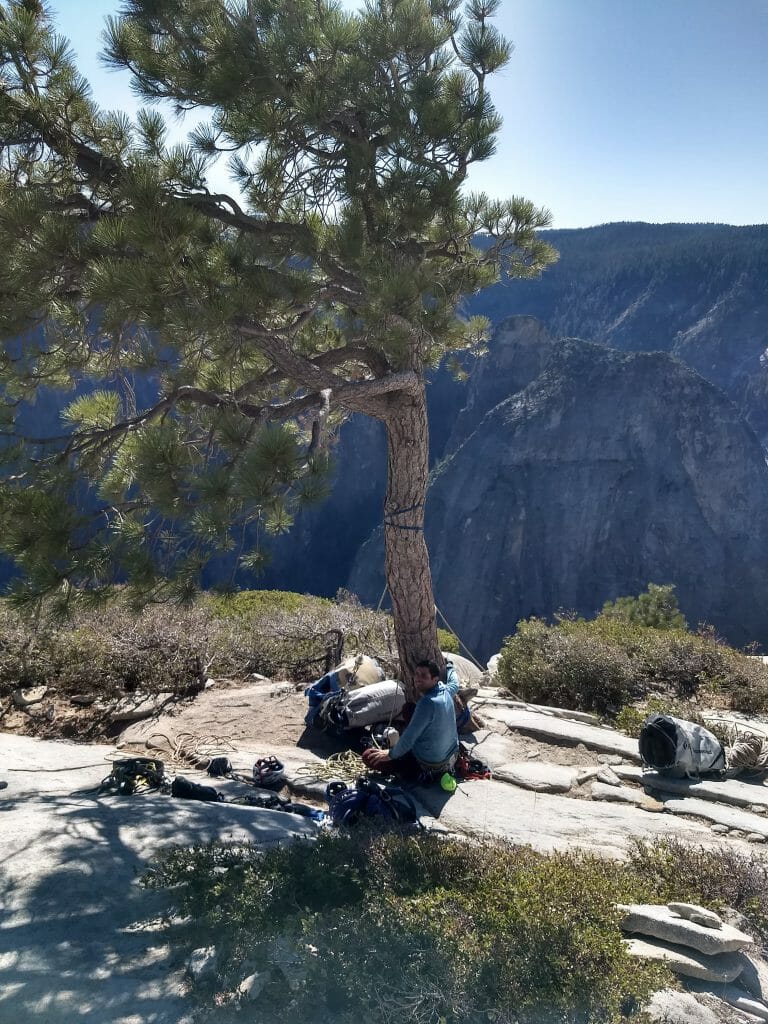
Now that I climbed El Cap before turning 40, I hope to do it again at 40 with my brother. But what I’m really looking forward to more than the climb itself is the process. Finding that structure and that rhythm again. Having something to look forward to every week because I have a bigger goal.
It’s a goal that helped me reconnect with my brother in profound ways. It’s a goal that gave purpose to my days. It took me on dozens of adventures in Yosemite and Joshua Tree. Like Steve House says, if you are going to climb Everest, let that be one of thousands of mountains. The Nose was one of many incredible climbs I did in the last few years, and just one of many to come. Everything that was nonessential fell away, because between being with my family and performing at my job and training, there wasn’t a lot of space for wasted time.
With my ascent of the Nose I showed my children the value of working hard toward a goal. I showed them that it is empowering to overcome fear—my fears of failure, of heights, of the unknown, of the belief that I am not fit. That I’m not an elite athlete. Yet somehow in 2019 in TrainingPeaks I managed to peak my CTL at 120, which Scott Johnston says “takes a helluva effort.”
Chasing a dream like the Nose expanded my sense of what is achievable. It also helped me zoom in on what is most important: my family, adventure, and the process of reaching for the impossible. Climbing is a visceral means of experiencing these life lessons, of living them in my body and not just in my mind.
-by Uphill Athlete Pedro Uranga
Cover photo: Getting granite mileage at Donner Summit with my daughter. Pedro Uranga Collection

